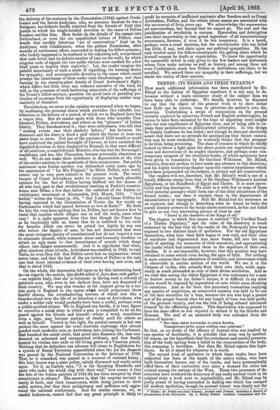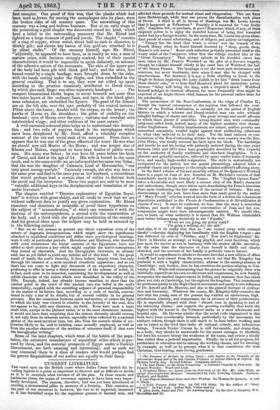THEBES : ITS TOMBS AND THEIR TENANTS.*
How much additional information has been contributed by Mr. Rhind to the history of Egyptian sepulture it is not easy to de- termine without a more extensive study of the subject than we have been able to undertake. We should, however, be disposed to say that the object of the present work is to show rather how little can be known, than to advertize the author's own dis- coveries. Undertaking a series of excavations on the ground recently explored by numerous French and English archieologists, he seems to have been animated by the hope of acquiring some insight into the real significance of Egyptian rites, and of being able to ex- plain their peculiarities on philosophical principles. In this design he frankly confesses he has failed; and though he does not absolutely assert that there are no grounds for anticipating that future excava- tors may be more successful, he evidently thinks that the prospect is far from being promising. The class of remains to which he chiefly looked to throw a light upon the above points are sepulchral inscrip- tions and decorations of an ampler character, and perhaps some con- temporary exegesis of the ritualistic books, of which specimens have been given in translation by Sir Gardiner Wilkinson. Mr. Rhind, however, does not profess to have made any advance in this direction; and his highly interesting chapter upon the various hypotheses which have been propounded on the subject, is critical and not constructive.
Our readers will see, therefore, that Mr. Rhind's work is one of a totally different stamp from that of Sir Gardiner Wilkinson's Ancient Egyptians, or his Handbook of Egypt and Thebes. It is more specu- lative and less descriptive. We meet in it with few or none of those vivid pictorial passages which form one of the chief attractions of the former works ; nor does it emulate them in the departments of natural history or topography. Still Mr. Rhind had his successes as an explorer, and though in describing what he found he lacks the purely literary powers of the books above mentioned, he has not failed to give us one very interesting picture of what he saw "Down in the chambers of the Kings of old."
The chapter in which this occurs is entitled "The Unrifled Tomb of a Theban Dignitary," and the value of the discovery is much enhanced by the fact that all the vaults of the Necropolis have been exposed to two distinct kinds of spoliation. For the old Egyptians themselves, what time their faith began to wax cold, and their rites of sepulture had degenerated into mere forms, fell into the easy habit of ejecting the mummies of their ancestors, and appropriating the tombs which had contained them to the sepulture of their own families. It is not impossible, however, that this practice may have obtained to some extent even during the ages of faith. For nothing is more curious than the admixture of credulity and irreverence which is observable in certain nations of the world. We see it in the Chinese of to-day, who actually flout their own idols, while appa- rently as much persuaded as ever of their divine attributes. And as we read that among the oldest Egyptians it was customary for a man to borrow money on his father's corpse, it is difficult to say what limits would be imposed by supersition on acts which seem shocking to ourselves. And so far from this pecuniary transaction implying any species of scepticism, an uninterred mummy was held to be one of the best securities for a loan, because the son who kept a parent out of his proper funeral rites for any length of time was held guilty of the grossest impiety, and ran the risk of being refused interment himself by the officiating priests. This deprivation was supposed to have the same effect as was reputed to attend it by the Greeks and Romans. The soul of an unburied body was excluded from the shores of heaven : "Nee ripas datur horrendas et rauca fluent; Transportare prius quam sedibus ossa quierunt."
So that, as no doubt of the efficacy of funeral rites was implied by one species of familiarity, it is possible that none was by another. Of course, on the hypothesis that the embalment and careful preserva- tion of the body sprung from a belief in the resurrection of the body, this reasoning is worthless. But then Mr. Rhind rejects this hypo- thesis. So let it stand for whatever it is worth.
The second kind of spoliation to which these vaults have been subjected has been at the hands of the native tribes, who have built themselves houses out of the tombs, and have systematically rifled them of their curiosities ever since a demand for relics has existed among the nations of the West. These two processes of de- struction have rendered the discovery of any really ancient tomb in its original state a work next to impossibility, and Mr. Blind may be justly proud of having succeeded in finding one which has escaped all modern spoliation, though its present tenant was clearly not the
Thebes: its Tombs and their Tenants, Ancient and Present, including a Record of E.rcacations in the Necropolis. By A. Henry Rhind. London: Longmans and Co. first occupier. One proof of this was, that the planks which had been used as levers for moving the sarcophagus into its place, were the broken sides of old mummy cases. The unswathmg of this mummy was a long and tedious business. But at an early stage of the proceeding a gold chaplet was discovered round his head, which bred a belief in the surrounding peasantry that Mr. Rhind had lighted on a large treasure of gold and jewels. The chaplet "consists of a ring of copper, whose metal, about half an inch in diameter, is thickly gilt; and eleven bay leaves of thin gold are attached to it by pliant stalks." Of the mummy himself, says Mr. Rhind, "physically, he appeared to have been, as in reality he was, a man of mature years, with features strongly marked, but of their special characteristics it would be impossible to speak definitely, on account of the adhesive nature of the cerements. The skin of the upper part of the body had been gilt with thick gold leaf; and the arms, first bound round by a single bandage, were brought down by the sides, with the hands resting under the thighs, and then embedded in the general swathing. That is to say, they were not rolled up apart according to the practice commonly attributed to Greek times, by which also each finger was often separately. bandaged. . . . . The compact bitumenized cloths began to occur beneath not more than two outer layers of the ordinary linen, and here, in the black gluti- nous substance, are embedded the figures. The genii of the Amenti are on the left side, over the spot probably of the ventral incision; Pthah above the knees; Inubis with the corpse, on the breast ; the hawks of Horns on the shoulders ; the pillar of stability on the forehead ; eyes of Horns over the eyes ; vultures and scarabzei with outstretched wings; and othei emblems of the same nature." A. well-executed coloured plate helps us to understand this descrip- tion: and two rolls of papyrus found in the sarcophagus which have been deciphered by Mr. Birch afford a tolerably complete account of the era and social rank of its occupant: From these it appears that he was one of the great officers of the court. He was what we should now call Master of the Horse; and was keeper also of Iihemu and Mahan, supposed to have been bodies of public work- men. His name was Sebau ; he was born 63 years before the birth of Christ, and died at the age of 54. His wife is buried in the same tomb, and in the same scrolls we areinformed that her name was Tabai ; that she was the daughter of Calasaris, Lord of Hermonthis, "one very great among mortals." Curiously enough, she also was born in the same year and died in the same year as her husband, a coincidence that would perhaps lead a certain class of critics to distrust both the scroll and the interpreter. These two papyri are: said to be most "valuable additional keys to the decipherment and translation of de- motic literature."
The chapter entitled "Theories explanatory of Egyptian Sepul- ture" is written with great ability, and all tends to show that we are without sufficient data to justify any given explanation. Mr. Rhind examines and dismisses as incapable of proof three hypotheses on the subject of "mummification," of which one connects it with the doctrine of the metempsychosis, a second with the resurrection of the body, and a third with the physical constitution of the country. And his general ideas upon the subject may be held as summed up in the following extract :
"But we do not possess at present any direct exposition even of the nature of dogmatic interpretations, which might show the significance attached to sepulchral conditions and define their psychological bearings, were it only at particular periods. Herodotus and Diodorus, who describe with some minuteness the burial customs of the Egyptians, have not added to their pictures a key which might explain the native conceptions then bound up therewith. And the hieroglyphic literature, as already said, has as yet failed to yield any definite aid of this kind. Of the great result of death, the soul's futurity, it does, indeed, largely treat, but only through the channel of a most mystical ritualistic apparatus ; and as yet there has not come to light any document of an ' expository character, professing to offer in terms a direct statement of the scheme of belief, if, in fact, such were to be expected, considering the developmental as well as subtle character of the tenets which ever flourished in the valley of the Nile. Enough, indeed, has already become manifest to show that the central point in the creed of this ancient race was belief in the soul's immortality, coupled with the ennobling adjunct of personal responsibility in the matter of its future fate, according to a code of morals, conven- tional in only a few of its details, but of eternal validity in its general precepts. But the connexion between spirit and matter, or rather the light in which the body was viewed in relation to the futurity of the soul, does not appear to be, with any clearness, set forth. Even were such a topic dealt with, except in the plainest terms, or in the most elementary manner, it would not have been surprising that the utmost obscurity should enwrap it, not only from its inherent nature, especially when reflected by a national genius of the most mystical type, but also from the esoteric modes of ex- pression likely to be, and in existing cases actually employed, as well as from the peculiar character of the medium of utterance itself, if that were the hieroglyphic writing."
Some of the later chapters, which treat of the habits of the popu- lation, the extensive manufacture of sepulchral relics which is pur- sued by them, and the material prospects of Egypt under a Turkish Government, are both amusing and interesting; and as such we may commend them to a class of readers who would perhaps find the graver disquisitions of our author not equally to their fancy.































 Previous page
Previous page